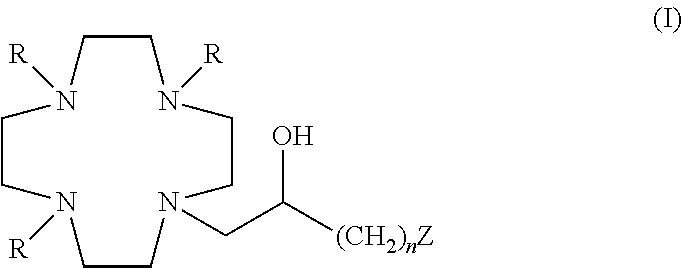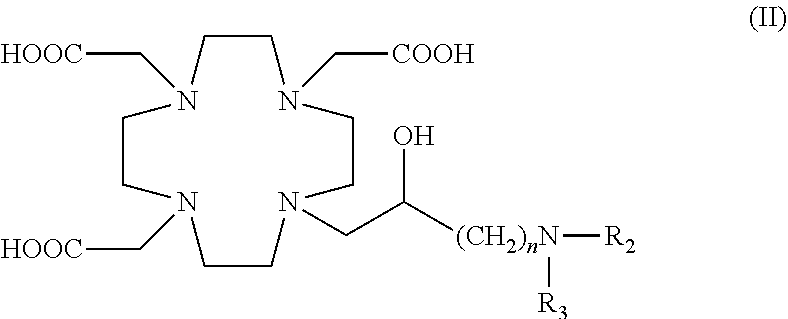Contrast agents
a contrast agent and contrast technology, applied in the field of diagnostic imaging, can solve the problems of shortening the acquisition time of the imaging process, and achieve the effect of improving relaxivity and favorable characteristics
- Summary
- Abstract
- Description
- Claims
- Application Information
AI Technical Summary
Benefits of technology
Problems solved by technology
Method used
Image
Examples
example 1
on of the Substrate 1B
[0216]
[0217]This compound was obtained by using the synthetic procedure shown in Scheme 6:
[0218]comprising:
[0219]a) Preparation of Compound 3
[0220]A solution of DO3A tris(t-butyl ester) 1 (Org. Synth. 2008, 85, 10) (61.7 g; 0.12 mol), intermediate 2 (obtained as reported in WO2008 / 126034, page 102) (30.0 g; 0.15 mol) and N,N-diisopropylethylamine (DIPEA) (61.8 g; 0.48 mol) in acetonitrile (300 mL) was stirred at 60° C. for 48 h. The mixture was evaporated to a residue which was dissolved in EtOAc (300 mL). The solution was washed with water (4×50 mL), brine (4×50 mL), filtered and evaporated to a residue that was purified by flash-chromatography (eluent: EtOAc / MeOH=1:1). Fractions containing the desired product were combined and evaporated to a residue which was treated with ethyl ether (200 mL). Intermediate 3 precipitated as a solid which was filtered (48.2 g). Yield 56%.
[0221]m. p.=168° C.
[0222]1H-NMR, 13C-NMR and mass spectrum are consistent with the expect...
example 2
on of the Substrate 1C
[0226]
[0227]This compound was obtained by using the synthetic procedure shown in Scheme 7:
[0228]comprising:
[0229]a) Preparation of Compound 1C.
[0230]Commercially available epichloridrin 2 (10.5 mL; 137 mmol) was dissolved in acetonitrile (300 mL) and the resulting solution was slowly added at room temperature to a solution of DO3A tris-t-butyl ester 1A (Org. Synth. 2008, 85, 10) (14.1 g; 27.4 mmol) in acetonitrile (100 mL). The mixture was stirred for 24 h then more epichloridrin 2 (5.2 mL; 68 mmol) was added. After 24 h the mixture was evaporated and the residue purified by chromatography on silica gel (eluent: CH2Cl2 / MeOH=50:1→1:1) to give compound 1C (10.6 g). Yield 64%.
[0231]1H-NMR, 13C-NMR and mass spectrum were consistent with the expected structure.
example 3
on of the Comparative Compound 1
[0232]The preparation of the Comparative Compound 1 was obtained as shown in the following Scheme 8:
[0233]including:
[0234]a) Preparation of Intermediate 4
[0235]Trifluoroacetic acid (TFA) (130 mL) was added to the compound 3 (obtained as above described in Example 1) (48.0 g; 0.066 mol), cooled with an ice bath. After stirring the mixture for 24 h, ethyl ether (800 mL) was added to the crude reaction leading to the formation of a solid precipitate which was filtered, washed with ethyl ether and dried to give a crude product that was dissolved in water (100 mL) and purified by chromatography on Amberchrome CG161M. By concentration of the pure fractions the desired intermediate 4 was obtained as a glassy residue (20.3 g). Yield 55%.
[0236]HPLC 94% (area %)
[0237]1H-NMR, 13C-NMR and mass spectrum were consistent with the expected structure.
[0238]b) Preparation of Ligand 5
[0239]A solution of intermediate 4 (19 g; 0.034 mol) in water (100 mL) and THF (100 mL)...
PUM
 Login to view more
Login to view more Abstract
Description
Claims
Application Information
 Login to view more
Login to view more - R&D Engineer
- R&D Manager
- IP Professional
- Industry Leading Data Capabilities
- Powerful AI technology
- Patent DNA Extraction
Browse by: Latest US Patents, China's latest patents, Technical Efficacy Thesaurus, Application Domain, Technology Topic.
© 2024 PatSnap. All rights reserved.Legal|Privacy policy|Modern Slavery Act Transparency Statement|Sitemap



